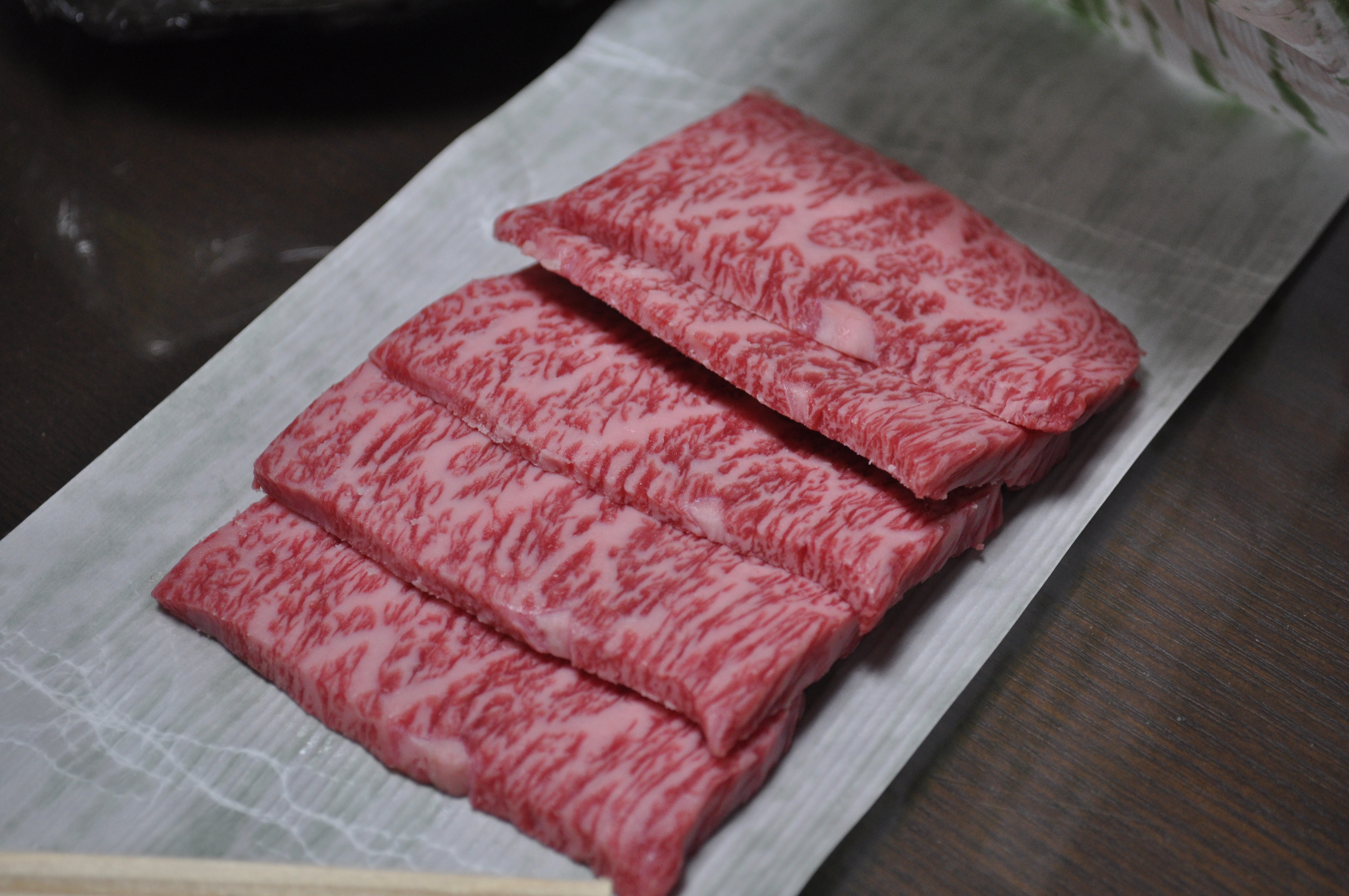Matsusaka Beef on:
[Wikipedia]
[Google]
[Amazon]
is the meat of Japanese Black cattle reared under strict conditions in the Matsusaka region of Mie in Japan. It has a high fat-to-meat ratio. Within Japan, it is one of the three ''Sandai Wagyū'', the "three big beefs"; the others are

 Before the 19th century, beef was not typically a part of the average Japanese diet. Farmers in the
Before the 19th century, beef was not typically a part of the average Japanese diet. Farmers in the
''JapanBrand''. Japan National Tourism Organization.Accessed January 2018. In order for the meat to be sold under the Matsusaka name, it must meet strict standards. Only virgin female cows can be sold as Matsusaka beef and all calves must be of a breed registered by the Matsusaka Beef Management System. Most of the meat is sold through stores owned by the Matsusaka Beef Cattle Association. ditorial(June 2016)
Matsusaka Beef, the Ultimate Wagyu: a Visually-Arresting and Delicious Work of Art
''Japan Quality Review''. To prevent cheap meat from being sold under the Matsusaka name, all authentic stores have an "Association Member's Certificate". The Mie Prefecture Matsusaka Shokuniku Kosha public corporation implemented a system for tracking the cows to ensure authenticity. All cattle are given a 10-digit ID. The date of birth, location of birth, date it was slaughtered, shipping information, and the bloodline of each cow can be found by entering the ID on a website.
"In Japan, A Steak Secret To Rival Kobe"
''
Kobe beef
is Wagyu beef from the Tajima strain of Japanese Black cattle, raised in Japan's Hyōgo Prefecture according to rules set out by the Kobe Beef Marketing and Distribution Promotion Association. The meat is a delicacy, valued for its flavor, ...
and Ōmi beef
is ''wagyū'' (Japanese beef) originating in the Shiga Prefecture, Japan. Ōmi means Ōmi Province, predecessor of Shiga. Ōmi beef is generally considered one of the three top brands, along with Kobe beef and Matsusaka beef.
Ōmi beef is said t ...
or Yonezawa beef. About 2500 cows are slaughtered for Matsusaka beef each year; the meat commands high prices.
History

 Before the 19th century, beef was not typically a part of the average Japanese diet. Farmers in the
Before the 19th century, beef was not typically a part of the average Japanese diet. Farmers in the Mie Prefecture
is a prefecture of Japan located in the Kansai region of Honshu. Mie Prefecture has a population of 1,781,948 () and has a geographic area of . Mie Prefecture is bordered by Gifu Prefecture to the north, Shiga Prefecture and Kyoto Prefectur ...
would raise smaller and more muscular, female cows to do agricultural work. When westerners introduced them to eating beef, farmers began to raise the cows to have traits that were more favorable for human consumption. The "National Beef Exposition" awarded Matsusaka with the medal of high honor in 1938. The award helped make Matsusaka more well known. The beef became famous for its marbling, rich flavor, and tenderness.
Original standards
The cows take roughly three years to mature.Matsusaka Beef''JapanBrand''. Japan National Tourism Organization.Accessed January 2018. In order for the meat to be sold under the Matsusaka name, it must meet strict standards. Only virgin female cows can be sold as Matsusaka beef and all calves must be of a breed registered by the Matsusaka Beef Management System. Most of the meat is sold through stores owned by the Matsusaka Beef Cattle Association. ditorial(June 2016)
Matsusaka Beef, the Ultimate Wagyu: a Visually-Arresting and Delicious Work of Art
''Japan Quality Review''. To prevent cheap meat from being sold under the Matsusaka name, all authentic stores have an "Association Member's Certificate". The Mie Prefecture Matsusaka Shokuniku Kosha public corporation implemented a system for tracking the cows to ensure authenticity. All cattle are given a 10-digit ID. The date of birth, location of birth, date it was slaughtered, shipping information, and the bloodline of each cow can be found by entering the ID on a website.
Cooking
While Matsusaka beef can be eaten as a steak, there are more traditional methods of cooking the meat.Shabu-shabu
''Shabu-shabu'' ( ja, しゃぶしゃぶ, shabushabu) is a Japanese ''nabemono'' hotpot dish of thinly sliced meat and vegetables boiled in water and served with dipping sauces. The term is onomatopoeic, derived from the sound – "swish swi ...
is prepared with very thin slices of meat which are quickly dipped in a kelp broth and then eaten. Sukiyaki is a method that involves simmering thin slices of meat in a pot with a sauce of sugar, sake and soy sauce. After the meat has been cooked, it is removed from the pot, dipped in a raw egg and eaten. The melting in one's mouth sensation comes from the unsaturated fatty acids in the beef.
References
{{reflist, 45emFurther reading
* Stephanie Strom"In Japan, A Steak Secret To Rival Kobe"
''
The New York Times
''The New York Times'' (''the Times'', ''NYT'', or the Gray Lady) is a daily newspaper based in New York City with a worldwide readership reported in 2020 to comprise a declining 840,000 paid print subscribers, and a growing 6 million paid ...
'', 18 July 2001. Accessed 16 June 2008.
Beef
Japanese cuisine
Matsusaka, Mie